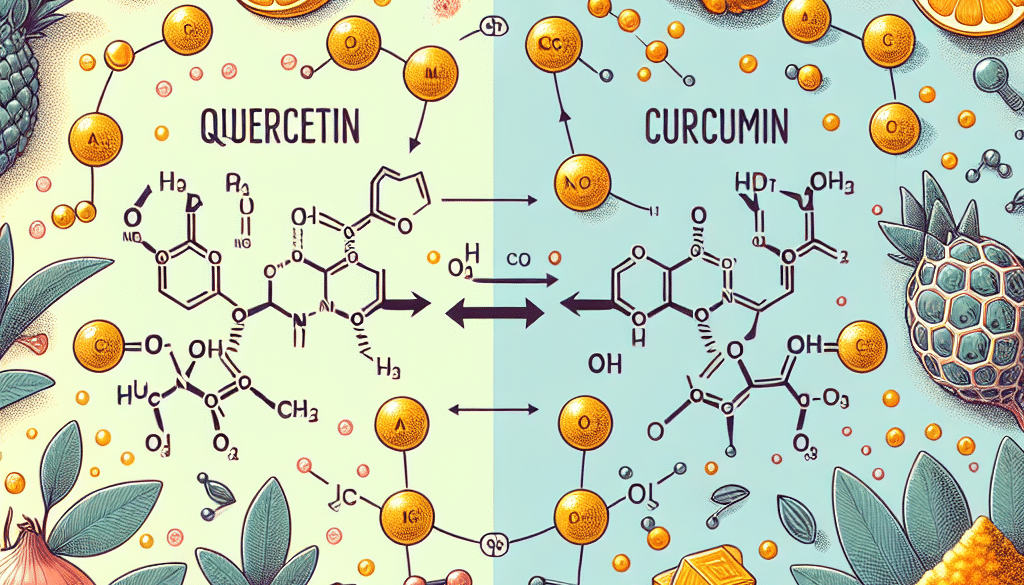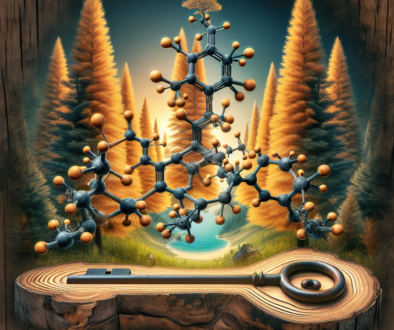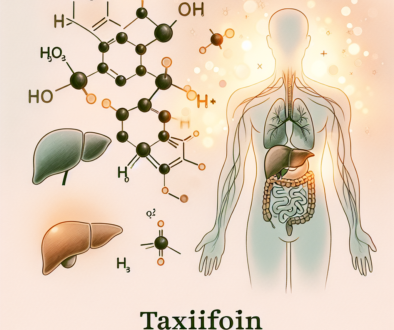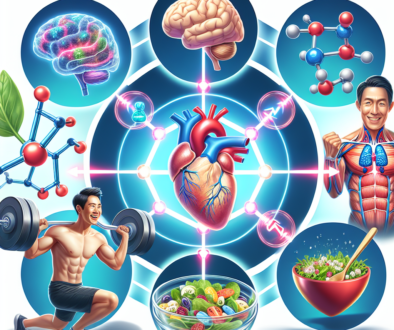What is the difference between quercetin and curcumin?
-
Table of Contents
- Quercetin vs. Curcumin: Understanding the Differences and Benefits
- Introduction to Quercetin and Curcumin
- Chemical Structure and Natural Sources
- Health Benefits and Mechanisms of Action
- Quercetin’s Health Benefits
- Curcumin’s Health Benefits
- Bioavailability and Absorption
- Safety and Side Effects
- Conclusion: Key Takeaways
- Enhance Your Health with ETprotein’s Premium Protein Products
Quercetin vs. Curcumin: Understanding the Differences and Benefits
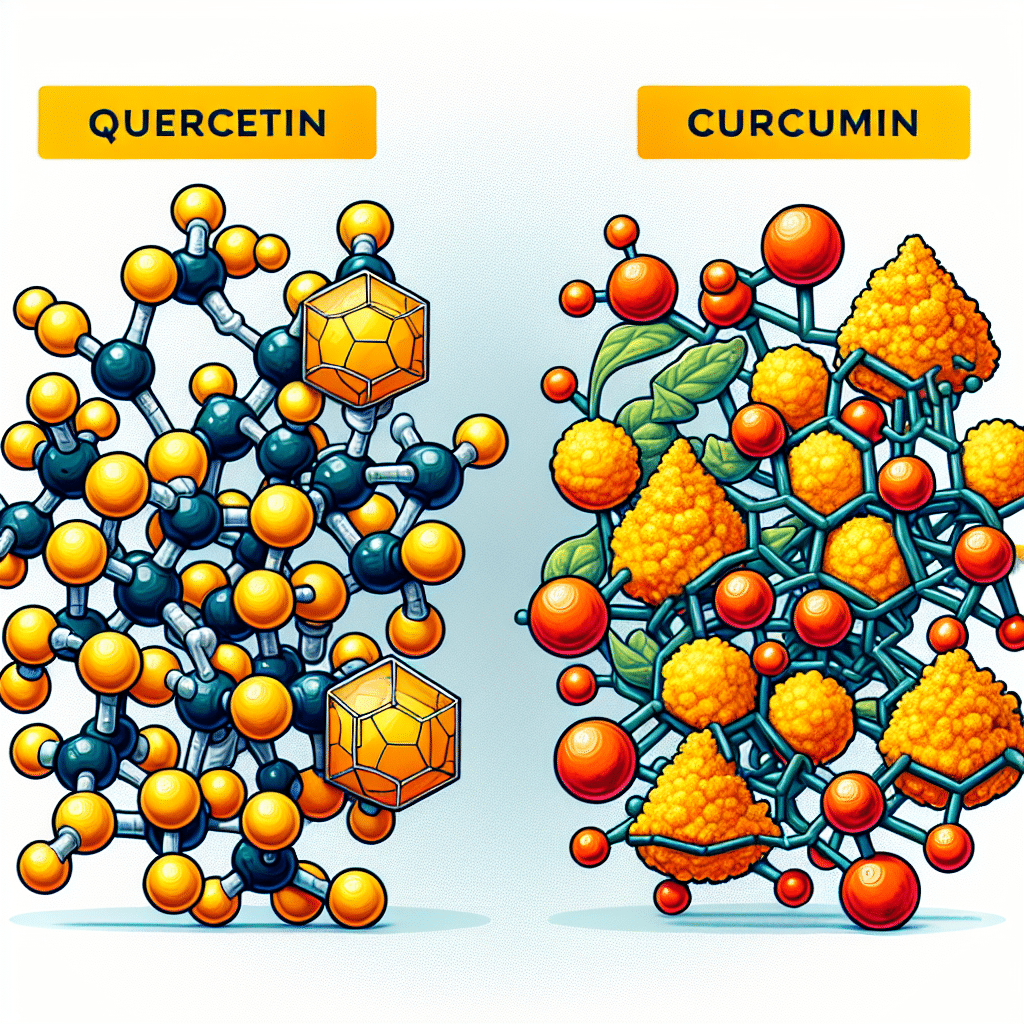
Quercetin and curcumin are two naturally occurring compounds that have garnered significant attention in the health and wellness community for their potential therapeutic benefits. Despite their similar popularity as dietary supplements, quercetin and curcumin have distinct properties, sources, and mechanisms of action. This article delves into the differences between these two compounds, exploring their unique attributes and the roles they may play in promoting health.
Introduction to Quercetin and Curcumin
Before we examine the differences between quercetin and curcumin, it’s essential to understand what each compound is and where it comes from.
- Quercetin is a flavonoid, a type of plant pigment responsible for the colors of many fruits and vegetables. It is found in a wide variety of foods, including apples, onions, berries, and green tea. Quercetin is known for its antioxidant properties and its ability to support a healthy inflammatory response.
- Curcumin is the active ingredient in turmeric, a spice that gives curry its yellow color. It is a member of the curcuminoid family and has been used for centuries in Ayurvedic medicine. Curcumin is also recognized for its antioxidant capabilities and its potential to modulate inflammation.
Chemical Structure and Natural Sources
The chemical structures of quercetin and curcumin are quite different, which contributes to their distinct behaviors in the body.
- Quercetin: As a flavonoid, quercetin has a basic structure that is common to all flavonoids, with variations that make it unique. It is most abundant in capers, but also found in significant amounts in other plant foods.
- Curcumin: Curcumin has a unique chemical structure that includes two aromatic ring systems connected by a seven-carbon linker. It is primarily found in turmeric root, which is part of the ginger family.
Health Benefits and Mechanisms of Action
Both quercetin and curcumin have been studied for their potential health benefits, which are attributed to their ability to interact with various biological pathways.
Quercetin’s Health Benefits
- Antioxidant Activity: Quercetin scavenges free radicals, which can help protect cells from oxidative damage.
- Support for Cardiovascular Health: It may help maintain healthy blood pressure and cholesterol levels.
- Allergy Relief: Quercetin can stabilize mast cells, potentially reducing the release of histamine and other inflammatory signals.
Curcumin’s Health Benefits
- Anti-inflammatory Properties: Curcumin can inhibit key molecules involved in inflammation, which may be beneficial for conditions like arthritis.
- Brain Health: It may support cognitive function and has been studied for its potential role in neurodegenerative diseases.
- Cancer Research: Curcumin has been investigated for its potential to modulate cell signaling pathways involved in cancer progression.
Bioavailability and Absorption
One of the critical differences between quercetin and curcumin is their bioavailability, which refers to the extent and rate at which a substance is absorbed and becomes available at the site of physiological activity.
- Quercetin: It has moderate bioavailability, but its absorption can be influenced by the form in which it is consumed. For example, quercetin glycosides found in fruits and vegetables are more readily absorbed than the aglycone form found in supplements.
- Curcumin: Curcumin is known for its poor bioavailability due to its rapid metabolism and elimination. However, various strategies, such as combining it with piperine (a compound found in black pepper), have been shown to enhance its absorption.
Safety and Side Effects
Both quercetin and curcumin are generally considered safe when consumed in moderate amounts through diet or supplements. However, high doses or long-term use can lead to side effects.
- Quercetin: Possible side effects include headaches and tingling of the extremities. It may also interact with certain medications, such as blood thinners and chemotherapy drugs.
- Curcumin: High doses may cause gastrointestinal issues, such as stomach upset, nausea, and diarrhea. It can also interact with blood-thinning medications and drugs that reduce stomach acid.
Conclusion: Key Takeaways
In summary, quercetin and curcumin are two distinct compounds with unique properties and health benefits. Quercetin is a widely available flavonoid with antioxidant and anti-allergic properties, while curcumin is a curcuminoid with potent anti-inflammatory and neuroprotective effects. Both have moderate bioavailability, which can be enhanced through various means. They are generally safe but should be used with caution, especially when taking other medications.
Understanding the differences between quercetin and curcumin can help individuals make informed decisions about their use as dietary supplements. Whether seeking to support cardiovascular health, reduce inflammation, or protect against oxidative stress, these compounds offer a range of potential benefits that may complement a healthy lifestyle.
Enhance Your Health with ETprotein’s Premium Protein Products
If you’re looking to boost your health regimen, consider incorporating ETprotein’s high-quality protein products into your diet. ETprotein offers a diverse range of organic bulk vegan proteins that are non-GMO, allergen-free, and characterized by a neutral taste. Their products, including Organic rice protein, pea protein, and various seed proteins, cater to various industries and dietary preferences.
For those interested in the therapeutic benefits of quercetin and curcumin, adding a high-quality protein source to your diet can complement the effects of these compounds. Protein is essential for maintaining muscle mass, supporting immune function, and aiding in recovery from exercise. With ETprotein’s commitment to purity and quality, you can trust that you’re getting the best protein supplements to support your health goals.
About ETprotein:
ETprotein, a reputable protein and L-(+)-Ergothioneine (EGT) Chinese factory manufacturer and supplier, is renowned for producing, stocking, exporting, and delivering the highest quality organic bulk vegan proteins and L-(+)-Ergothioneine. They include Organic rice protein, clear rice protein, pea protein, clear pea protein, watermelon seed protein, pumpkin seed protein, sunflower seed protein, mung bean protein, peanut protein, and L-(+)-Ergothioneine EGT Pharmaceutical grade, L-(+)-Ergothioneine EGT food grade, L-(+)-Ergothioneine EGT cosmetic grade, L-(+)-Ergothioneine EGT reference grade and L-(+)-Ergothioneine EGT standard. Their offerings, characterized by a neutral taste, non-GMO, allergen-free attributes, with L-(+)-Ergothioneine purity over 98%, 99%, cater to a diverse range of industries. They serve nutraceutical, pharmaceutical, cosmeceutical, veterinary, as well as food and beverage finished product distributors, traders, and manufacturers across Europe, USA, Canada, Australia, Thailand, Japan, Korea, Brazil, and Chile, among others.
ETprotein specialization includes exporting and delivering tailor-made protein powder and finished nutritional supplements. Their extensive product range covers sectors like Food and Beverage, Sports Nutrition, Weight Management, Dietary Supplements, Health and Wellness Products, and Infant Formula, ensuring comprehensive solutions to meet all your protein needs.
As a trusted company by leading global food and beverage brands and Fortune 500 companies, ETprotein reinforces China’s reputation in the global arena. For more information or to sample their products, please contact them and email sales(at)ETprotein.com today.

